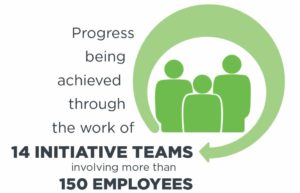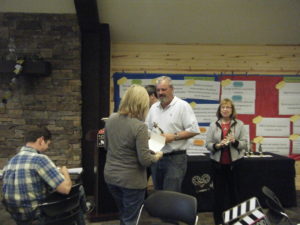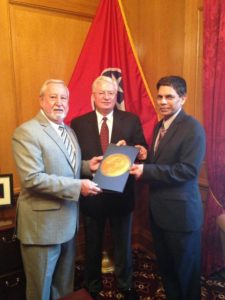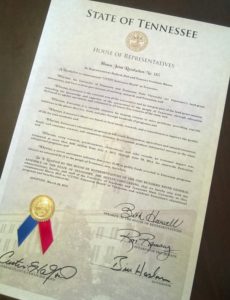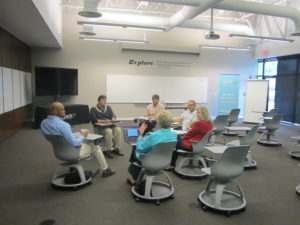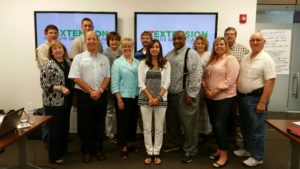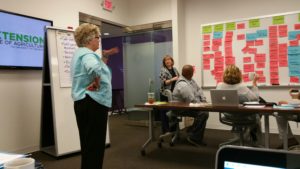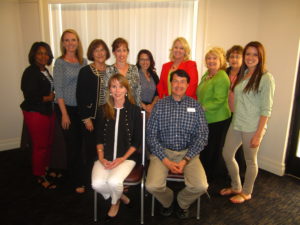Introduction
“The best way to predict your future is to create it.”
– Stephen Covey
The 2010-2020 Strategic Plan was introduced at the 2010 Extension Conference. Participants gave input for the plan’s implementation by completing “The Year Is 2020” activity sheets for each goal. Extension employees were asked to imagine themselves in the year 2020 and record what they see, hear, think, and feel. Another group that was polled was the Extension Advisory Committee. The feedback from both groups was synthesized and presented to the Implementation Committee, which met in July 2011. Subcommittees were assigned to each goal. The full list of committee members is below:
The goals of the retreat were to:
- Brainstorm implementation ideas.
- Review Strategic Plan and background data.
- Review summary of implementation ideas from State Extension Conference and Advisory Council.
- Review summary of “The Year Is 2020” activity.
- Discuss possible implementation plans.
- Select implementation plans using priority ratings.
- Design specific steps for implementing the plans.
- Develop timeline and assignments.
The team was asked to review each initiative using MUSTs and WANTs; if an initiative didn’t meet the MUSTs list, it was not included. The WANTs were weighted and the score was calculated. This was necessary to prioritize the list and focus efforts for the first phase of the Implementation Plan.
MUSTs List
- Supports Extension’s mission.
- Verifiable needs exist.
- Relevant to Tennessee (statewide).
- Research-based and/or best practices.
- Have or can acquire capacity (knowledge, skills, etc.).
- Topic or issue is timely today and will be for three- to five-year period.
- Has an economic, societal, or environmental impact.
- Impact can be monitored and measured.
- Resources are available or can be redirected or secured.
- Support UT Extension’s core values.
WANTs List
Weight
Complements or agrees with UT Extension’s organizational principles.
10
Consistent with/or addresses major trends.
9
Provides opportunity to reach new audiences or reach larger numbers of existing clientele.
8
Innovative concept, creative or new approach planned.
7
Opportunity to collaborate or form partnerships.
6
Opportunity for external funding/fee-based.
5
Provides opportunity for interdisciplinary contributions.
4
Workforce will be supportive.
3
Key stakeholders will be supportive.
2
Compatible with USDA NIFA.
1
In early 2012, a two-day retreat of regional and state administrators was held. The team included: Tim Cross, Robert Burns, Shirley Hastings, Joseph Donaldson, Lynn Brookins, Tim Fawver, Ben West, Herb Byrd, Steve Sutton, Connie Heiskell, Jim Stewart, and Lorna Norwood. At the retreat, a Matrix of Initiatives was presented. It featured four quadrants to facilitate the prioritization process. The matrix features axes of Critical to Desired and Short-term to Long-term. One short- and one long-term critical goal were identified by the Strategic Implementation subcommittees. The five priority short-term initiatives and five long-term priority initiatives were entered into the matrix, leaving thirty-eight initiatives considered desired at that time.
The critical/short-term goals were scheduled to be accomplished between 2012 and 2016 and included:
- Develop standards for offices and customer service (Future Growth).
- Develop or enhance leadership teams in all Extension base programs: ANR, FCS, 4-H, and RD (Innovative Programs).
- Recognize and reward outstanding performance at all levels of the organization (Human Capital).
- Establish new promotion process using the SUPER vita builder for non-tenure exempt staff (Efficiency).
- Increase visibility of Extension program (Visibility).
The critical/long-term goals were scheduled to be accomplished in a six- to ten-year period and included:
- Collection of funding initiatives: fee-based programs, grants, capacity, and gifts (Future Growth).
- Develop the BEST (Building Exceptionally Skilled Teachers) teachers by improving skill sets and methodology (Innovative Programs).
- Increase compensation packages to be comparable to the upper third of Extension peers (Human Capital).
- Review and document Extension policies and practices for consistency, efficiency, and clarity (Efficiency).
- Develop an effective marketing plan (Visibility).
At the retreat, administrators reviewed the matrix and clarified the meaning of each initiative. They were also each given the opportunity to select one initiative from either the desired/short-term or desired/long-term list. Then the group voted and if an initiative received more than eight votes, it was moved from the desired to the critical group. On the second day of the retreat, the Program Evaluation and Review Technique (PERT) was introduced. Using this technique, the group developed timelines, prioritized initiatives, confirmed milestones, developed sequence of initiatives, determined connections, and determined talent, people, and groups needed for the implementation of the ten initiatives.
Critical Short-term and Long-term Goals Matrix:
Desired Short-term and Long-term Initiatives:
